This post may contain affiliate links, which means I’ll receive a commission if you purchase through my links, at no extra cost to you. This helps keep the content on my site free. please read my disclosure here
Do you love the smell of fresh bread? Imagine sinking your teeth into a slice of homemade sourdough bread with a perfectly crispy crust and a pillowy soft center. My foolproof recipe makes it easier than you think to achieve sourdough perfection!
There’s nothing quite like the smell of fresh sourdough bread baking in your kitchen that wafts throughout the entire house. I’ve been tweaking this recipe for over 3 years, and I’m finally ready to share my tried-and-true method with you! This sourdough has a golden, crispy crust and an airy, soft center—the kind that makes you want to devour the entire loaf in one sitting! The best part? It’s mostly hands-off!
Yes, it takes about 2 days, but trust me, it’s SO worth the wait. Ready to make bakery-quality sourdough at home? Let’s get baking!
ChatGPT said:
Before we begin, please note that this recipe does not include making a sourdough starter from scratch. I’m using my well-maintained starter that I’ve been feeding for three years. This recipe is perfect for those who already have a sourdough starter ready to go!
*Good To Know*
- What is the significance behind scoring bread?
Scoring dough involves making cuts on the surface of your risen dough using a tool called a “lame” (pronounced ‘lahm’). This technique serves more than just an aesthetic purpose; it helps control how the loaf expands during baking. By guiding the expansion through the cuts you make, you can achieve a better shape and texture for your bread. - Why does it take 2 days to make this recipe?
The first day is dedicated to preparing the dough and allowing it ample time to ferment while laminating it (stretching and folding). This fermentation period is crucial for developing a stronger gluten structure, which enhances gas retention during baking. The result is a loaf that has a crispy exterior and an airy interior.
The second day is the result of cold proofing your dough overnight after fermentation. This method enhances the gluten structure and improves the flavour of the bread by slowing down yeast activity, allowing for a longer fermentation period that develops a more complex sour taste. Additionally, cold proofing makes scoring the bread easier. When you bake bread that has undergone cold proofing at a high temperature, it produces a crispier crust. - What is Autolyse (pronounced ‘aw-toe-lease’)?
It is the process of resting the dough after mixing the poolish, flour and water, but before adding other ingredients like salt and sugar. This step is essential for initiating gluten development and ensuring that the flour fully absorbs the water. - Why is it important to use filtered water to make sourdough bread?
Tap water often contains chlorine (and other chemicals), which can slow down or weaken the bacteria in your starter. This can result in poor fermentation and a dough that doesn’t rise properly. To avoid disappointment, use filtered water from the start. Additionally, letting this water reach room temperature before you begin will help the dough rise faster than if you used cold water.
Ingredients you will need:
For the Poolish & Dough:
- sourdough starter (room temperature)
- bread flour (preferably unbleached)
- salt
- sugar
- water (filtered and room temperature, see notes above)
- extra virgin olive oil
Tools:
- lame – a handle with a razor blade attached to score dough (or a sharp tool like a clean Exacto knife)
- Dutch Oven (large capacity – such as 5Qt. or 7 QT. recommended)
- water spray bottle
- parchment paper
- plastic wrap
- wire cooling rack
- hand towel
Part 1 - Prep the Poolish (The Flavour Booster!)
I recommend starting this recipe on a weekend and early in the morning, around 8 or 9 AM. Sourdough needs time to ferment and develop those beautiful flavours, and a slow rise gives the best results.
We’re starting with a poolish—a pre-ferment that boosts flavour and acts as the ‘yeast’ for your dough.
What You’ll Need:
- 100g bread flour (preferably unbleached)
- 100g filtered water (room temperature)
- 120g sourdough starter
I use metric measurements for accuracy since flour weight can vary, but if you do not have a kitchen scale, here are the imperial measurements.
- ¾ cup bread flour (preferably unbleached)
- ½ cup minus 2 teaspoons filtered water (room temperature)
- ½ cup sourdough starter
Tip
- If your kitchen is cooler (like mine!), place the bowl in the oven with the oven light on for gentle warmth. In warmer climates, just leave it on your counter.
- Bread flour is a must, due to its higher protein content, which helps absorb water and develop stronger gluten for a better rise and texture. Unbleached flour is preferred for its denser texture benefits, but bleached bread flour can be used if unbleached is unavailable.
Part 2 - Autolyse for Better Dough
Autolyse is a fancy word for letting your dough rest and hydrate before adding salt and sugar. This step helps develop the gluten, making your dough easier to handle.
When the poolish is ready, we’re ready to transform it into dough.
What You’ll Need (metric measurements):
- poolish from part 1
- 360g bread flour (preferably unbleached)
- 180g filtered water (room temperature)
- 1 teaspoon salt (kosher or sea salt)
- 1 teaspoon white sugar
or imperial measurements:
- poolish from part 1
- 2¼ cup bread flour (preferably unbleached)
- ¾ cup filtered water (room temperature)
- 1 teaspoon salt (kosher or sea salt)
- 1 teaspoon white sugar
2. After completing the Autolyse, mix the dough at medium speed for 7 minutes to develop gluten. If you’re kneading by hand, this will take around 15 minutes. The dough should look pliable and pull away from the bowl. Reduce the speed to medium-low and drizzle a little extra virgin olive oil in before stopping the mixer. This will coat the dough evenly and prevent it from sticking to the bowl while you remove it.
Tip
- While your dough rests, add 1 tsp. salt and 1 tsp. sugar to the bowl, but do not mix yet! This ensures you won’t forget to add them later!
- Bread flour quality varies by location due to different wheat types and protein content. While I’m sharing a reliable recipe, you may need to adjust the water amount. If the dough feels dry, add water a tablespoon at a time. If it’s too wet, sprinkle in bread flour a tablespoon at a time until it feels right.
Part 3 - Bulk Fermentation & Shaping
Here’s where the magic happens—bulk fermentation gives the dough time to rise and develop the delicious sour flavour this bread is known for.
1. Drizzle a little olive oil on your parchment paper, then place the dough on the paper and shape it into a round loaf with the seam side facing down. Using olive oil instead of flour to coat the dough helps prevent it from drying out too quickly while baking, and it also adds a delicious flavour. Be cautious not to use too much!
2. Next, transfer the dough to a large bowl. Loosely cover the top with plastic wrap, and place a kitchen towel on top. If you live in a cooler climate, you can place the bowl in your oven with the oven light on to provide gentle warmth. If you reside in a warmer climate, simply leave the bowl on your counter to allow the dough to rise. The initial proofing period lasts the longest, taking 2 to 4 hours until it has doubled in size and looks visibly puffy.
Laminating Dough
To laminate means to stretch and fold a layer of dough over itself to strengthen the gluten structure and to trap air. After the first proofing is complete and the dough has doubled in size, do the following:
Remove the hand towel and plastic wrap (but save it for reuse). Lift the parchment out of the bowl, then gently stretch and fold the dough like an envelope as follows:
- Lightly stretch then fold the top to the center
- Lightly stretch then fold the bottom to the center
- Repeat with the left and right sides
- Lift, pinch, and twist the dough to seal, then flip it over and place the dough seam-side down onto the paper.
Roll the dough around gently to reshape the loaf, then lift the parchment and place your dough back into the bowl. No extra oil is needed as long as the dough stays non-stick. Use any excess oil from the parchment as necessary. Cover with plastic wrap and the hand towel again. Set a timer for 40 minutes. Repeat this process three more times, with each interval lasting 40 minutes. Flip the dough over first before you start stretching and folding the dough each time you laminate it, This will ensure that the seam remains on the same side throughout the process.
Part 4 - Overnight Cold-Proofing
After completing your final proofing, stretch, fold, and pinch the dough. Next, place the covered bowl with the dough in the refrigerator, ensuring there is enough space for the dough to rise without being compressed or obstructed. Cold fermentation enhances the development of gluten structure and improves the flavour of the bread by slowing down yeast activity. This results in a longer fermentation period, which creates a more complex sour flavour. Additionally, it makes scoring the bread easier. This overnight refrigeration is the longest hands-off time you’ll spend with the dough before baking it the next day.
Part 5 - Scoring & Baking for That Crispy Crust
Scoring (or making cuts) on the surface of the dough with a lame isn’t just for looks; it helps control how the loaf expands while baking. By directing the expansion through the cuts, you can achieve a better shape and texture for your bread. Feel free to get creative and have fun trying out different patterns! There’s no right or wrong way to do this, so just enjoy the process! Personally, I find it very therapeutic.
Tips for a Crispy Crust
Water Spray Bottle: Creating steam in both the oven and the Dutch oven during the initial baking process helps prevent the crust from browning too quickly. This allows for better rising and a better crust without burning the loaf. The steam also produces beautiful, crispy bubbles on the surface of the loaf.
Dutch Oven (7 Qt.): This pot is an essential cookware in my kitchen. It traps steam to create a controlled baking environment while retaining the heat necessary for a crispy crust. Be sure to use the largest Dutch oven you have, as this will allow the bread to expand while it bakes.
High Temperature: High heat is essential for baking a loaf that has a bakery-quality crust and an irresistible texture.
Cooling Wire Rack: This underrated tool allows heat to escape, cooling the bread effectively without condensation.
1. Preheat your oven to 475°F (246°C). If you are using a convection setting, adjust the temperature to 450°F (232°C). Make sure to position your oven racks on the lowest and mid-lowest levels. While the oven preheats, place a baking tray on the lowest rack and your Dutch oven on the mid-lowest rack. The baking tray will help prevent the bottom of your bread from burning during baking in the Dutch oven. Preheating the Dutch oven is needed as it needs to be hot for optimal baking. You can’t help but smile as you hear that satisfying sizzle when you place your dough inside! It’s the perfect sound of your hard work paying off—soon, to be rewarded with delicious homemade bread!
2. Using oven mittens, carefully remove your preheated Dutch oven and place it on your stovetop. Take off the lid and transfer your dough, along with the parchment paper, into the pot. Using a spray bottle filled with cold filtered water, mist the dough generously. Then drizzle a little extra virgin olive oil (EVOO) on top and, if desired, sprinkle some sea salt over the surface. With oven mittens, close the lid and return the Dutch oven to the mid-lowest rack above the baking pan. Set your timer for 30 minutes.
After 30 minutes, carefully remove the lid of the Dutch oven using oven mittens. Spray additional water on the surface of your bread as well as inside the oven. Then, close the oven door and continue baking the bread without the Dutch oven lid until it turns golden brown. This will take another 10 – 15 minutes.
Let your baked sourdough bread cool on a wire rack for 1 hour before slicing. This cooling time allows the bread to develop a delicious, crispy crust while retaining a soft center.
I know it’s tough to resist the urge to slice into that fresh bread while it’s cooling down, but trust me, your patience will be rewarded! Once it’s ready, you’ll have a delicious, crusty loaf to savour with every single bite. Enjoy!
Foolproof Sourdough Bread with a perfectly Crispy Crust and Soft Center
Ingredients
For the Poolish (pre-ferment)
- ¾ cup unbleached bread flour
- ½ cup (minus 2 teaspoons) filtered water, room temperature
- ½ cup sourdough starter, room temperature
For the Dough
- 2¼ cup unbleached bread flour
- ¾ cup filtered water, room temperature
- 1 teaspoon salt, kosher or sea salt
- 1 teaspoon white sugar
- 1 Tablespoon olive oil, extra virgin
INSTRUCTIONS
FOR THE POOLISH (PRE-FERMENT)
- In a medium glass bowl, mix unbleached bread flour, filtered water, and sourdough starter until combined. Cover with plastic wrap and a clean towel, and let it sit until it doubles in volume and small bubbles have formed, indicating the pre-ferment is active. Usually takes between 2 – 4 hours depending on the room temperature or cold ingredients used. In cooler climates, place the bowl in the oven with the oven light on for gentle warmth. In warmer climates, leave it on the counter to rise. *See Tips for more information.*
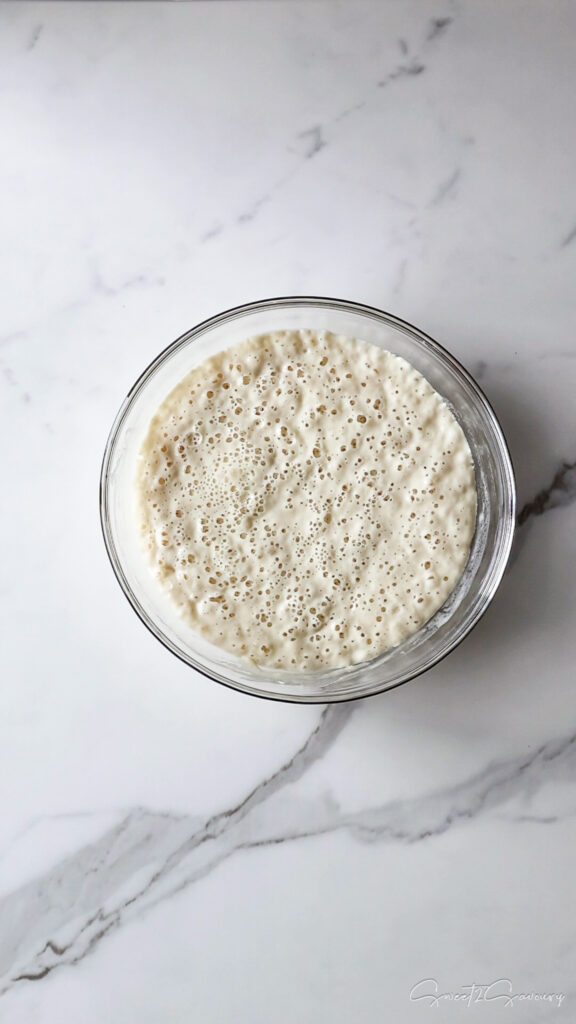
FOR THE DOUGH
- Use a dough hook to mix the Poolish, bread flour, and water in your stand mixer at low speed until just combined. Stop the machine, cover the bowl with a clean towel, and let it rest for 20 minutes for the Autolyse phase. *See Tips for more information.*
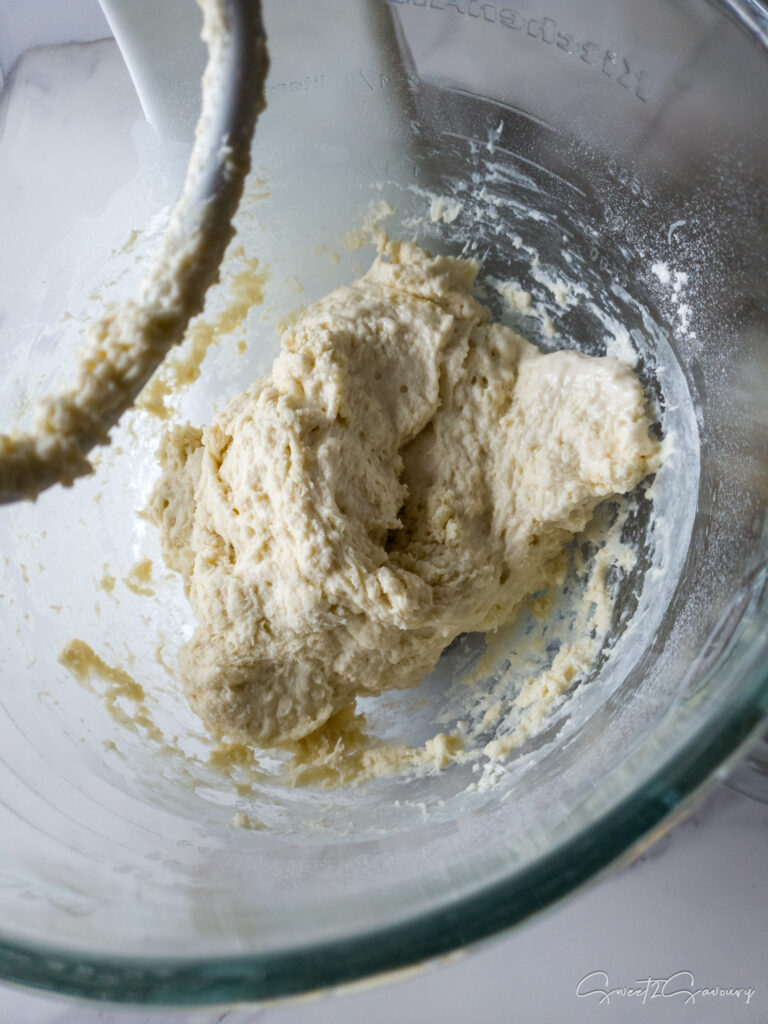
- After the autolyse, add 1 teaspoon kosher salt and 1 teaspoon white sugar. Mix at medium speed for 7 minutes until the dough is pliable and pulls away from the bowl. If you're kneading by hand, this will take around 15 minutes. Then, reduce the speed to medium-low and drizzle in a little extra virgin olive oil to prevent sticking before stopping the standmixer.

- Drizzle a small amount of extra virgin olive oil on parchment paper, then place the dough on it, shaping it into a round loaf with the seam side down. Coat the dough evenly with the oil on the parchment paper. Using olive oil instead of flour helps prevent the dough from drying out and adds flavour, but use it sparingly.

- Transfer the dough to a large bowl and loosely cover it with plastic wrap, placing a kitchen towel on top. The initial proofing takes 2 to 4 hours, until it has doubled in size and is puffy.
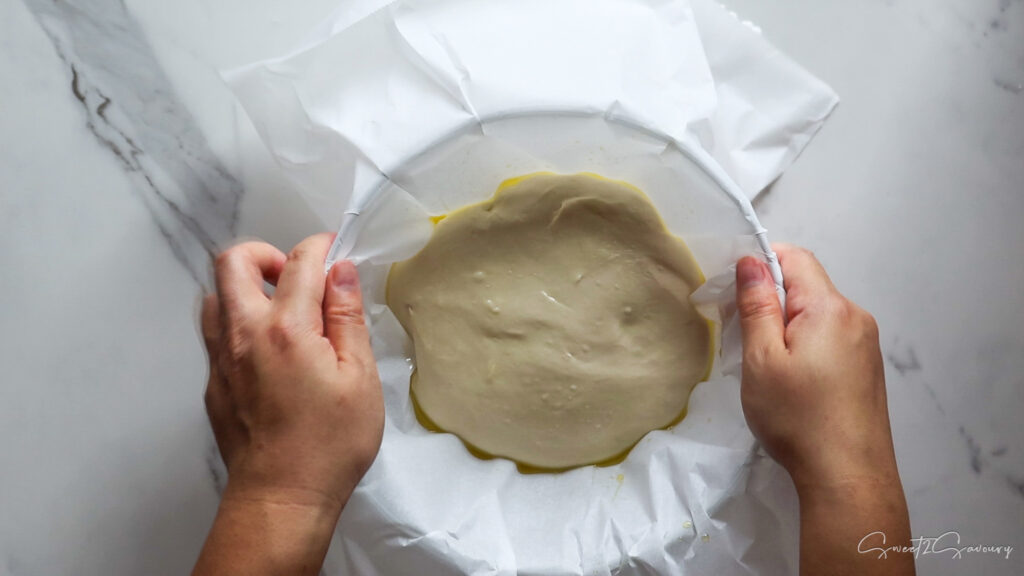
LAMINATING THE DOUGH
- To laminate dough means to stretch and fold it to strengthen the gluten and trap air. After the first proofing, do the following:1. Remove the towel and plastic wrap (save for reuse).2. Lift the dough from the bowl and fold it like an envelope: – Stretch and fold the top, then the bottom to the center. – Repeat with the left and right sides, folding to the center.3. Pinch and twist the dough to seal, then place it seam-side down on parchment. 4. Gently reshape the loaf, lift the parchment, and return it to the bowl. No extra oil is needed unless the dough sticks. 5. Cover again and set a timer for 40 minutes. Repeat this process three more times, each after 40 minutes. Flip the dough over first before you start stretching and folding the dough each time you laminate it. This will ensure that the seam remains on the same side throughout the process.
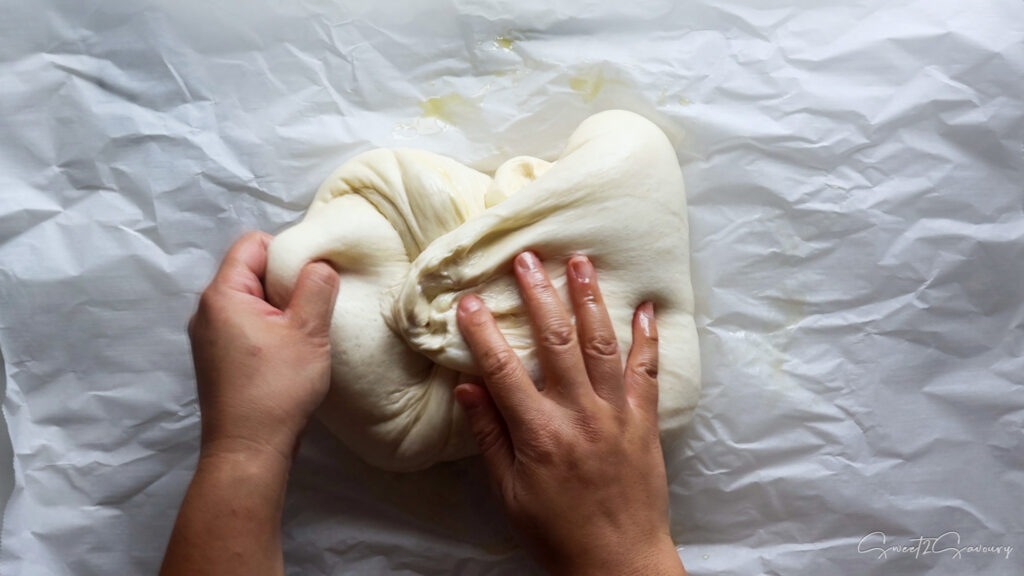
- After your final proofing, stretch, fold, and pinch the dough. Then, cover the bowl with plastic wrap and a clean hand towel. Refrigerate it for overnight cold fermentation. Ensure there’s enough space in the fridge for the dough to rise without being compressed. This overnight refrigeration is the longest hands-off time you'll spend with the dough before baking it the next day.
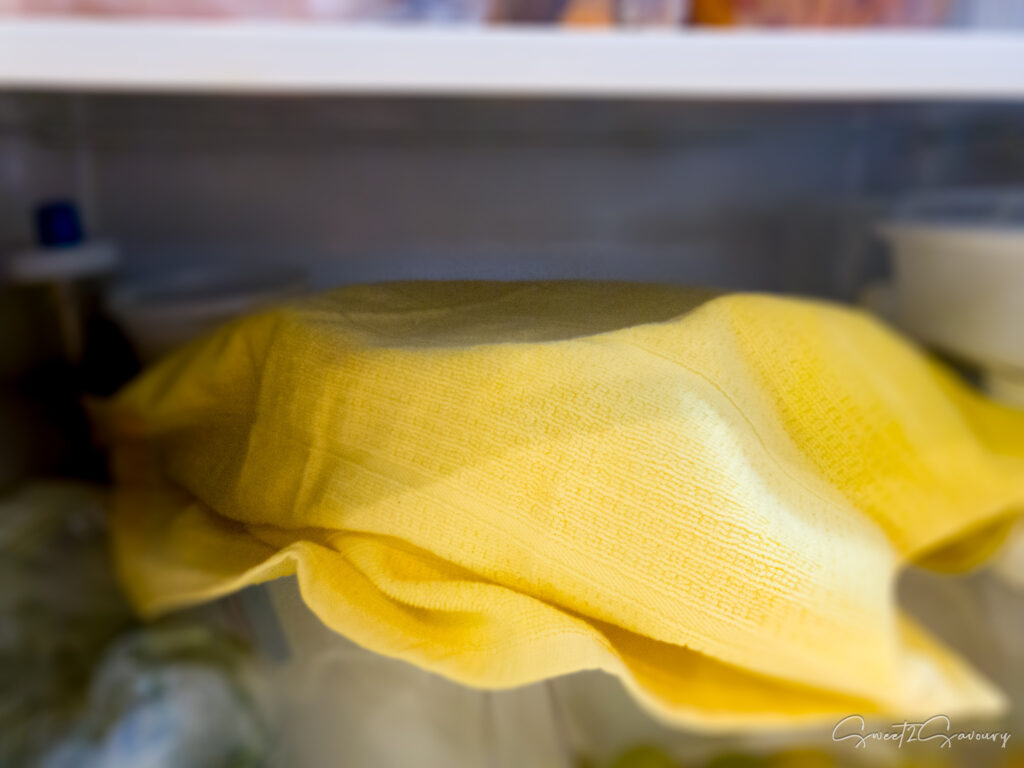
THE NEXT DAY
- When you're ready to bake, preheat your oven to 475°F (246°C). If you are using a convection setting, adjust the temperature to 450°F (232°C). Make sure to position your oven racks on the lowest and mid-lowest level. While the oven preheats, place a baking tray on the lowest rack and your Dutch oven on the mid-lowest rack. The baking tray will help prevent the bottom of your bread from burning during baking in the Dutch oven.
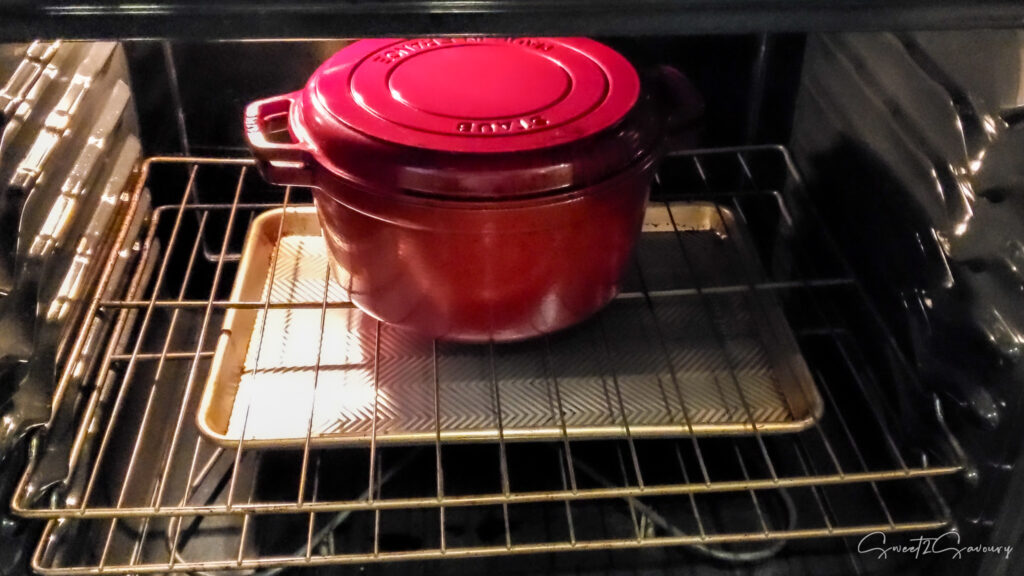
- Score your dough with a sharp lame or clean Exacto knife.
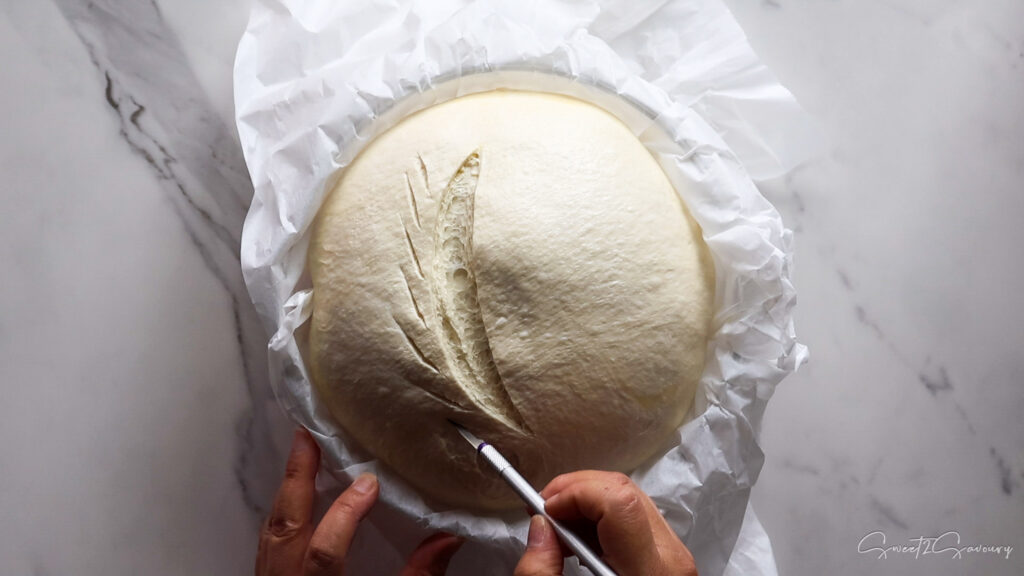
- Using oven mittens, carefully remove your preheated Dutch oven and place it on your stovetop. Take off the lid and transfer your dough, along with the parchment paper, into the pot. Using a spray bottle filled with cold filtered water, mist the dough generously. Then drizzle a little extra virgin olive oil (EVOO) on top and, if desired, sprinkle some sea salt over the surface. With oven mittens close the lid and return the Dutch oven to the mid-lowest rack above the baking pan. Set your timer for 30 minutes.
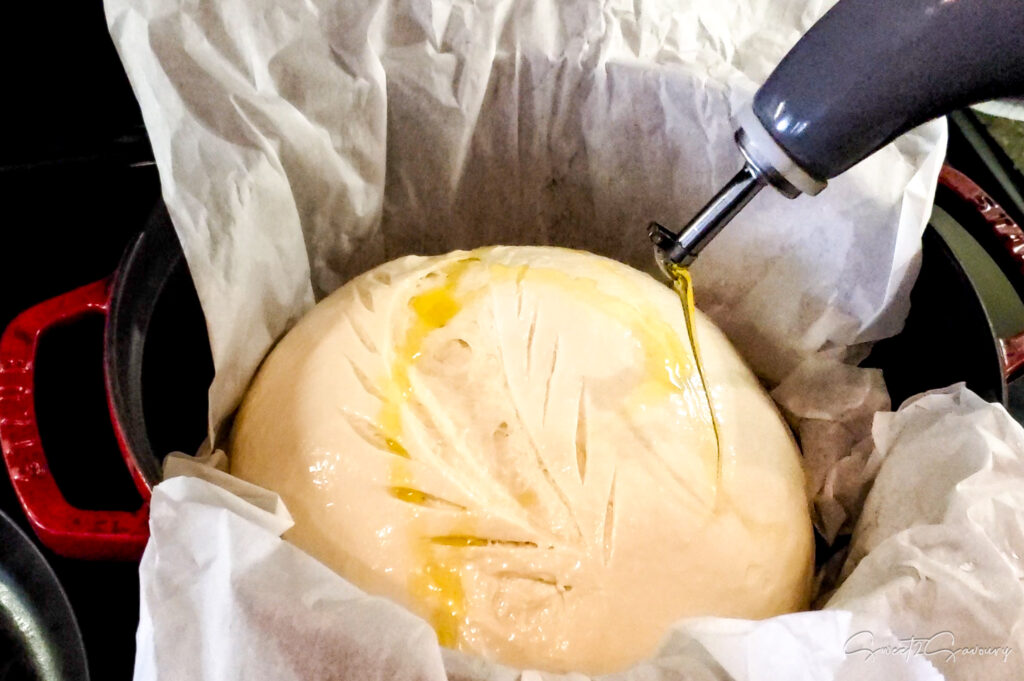
- After 30 minutes, carefully remove the lid of the Dutch oven using oven mittens and rotate the pot 180° (ensures even baking). Spray additional water on the surface of your bread as well as inside the oven. Then, close the oven door and continue baking the bread without the Dutch oven lid until it turns golden brown. This will take about 10 – 15 minutes.
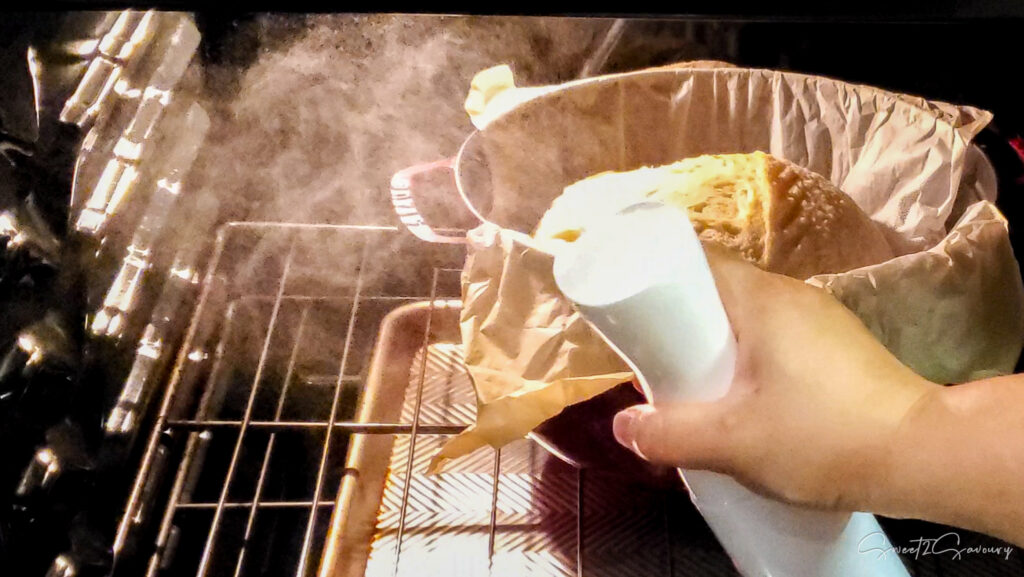
- Let your baked sourdough bread cool on a wire rack for 1 hour before slicing. This cooling time allows the bread to develop a delicious, crispy crust while retaining a soft center.
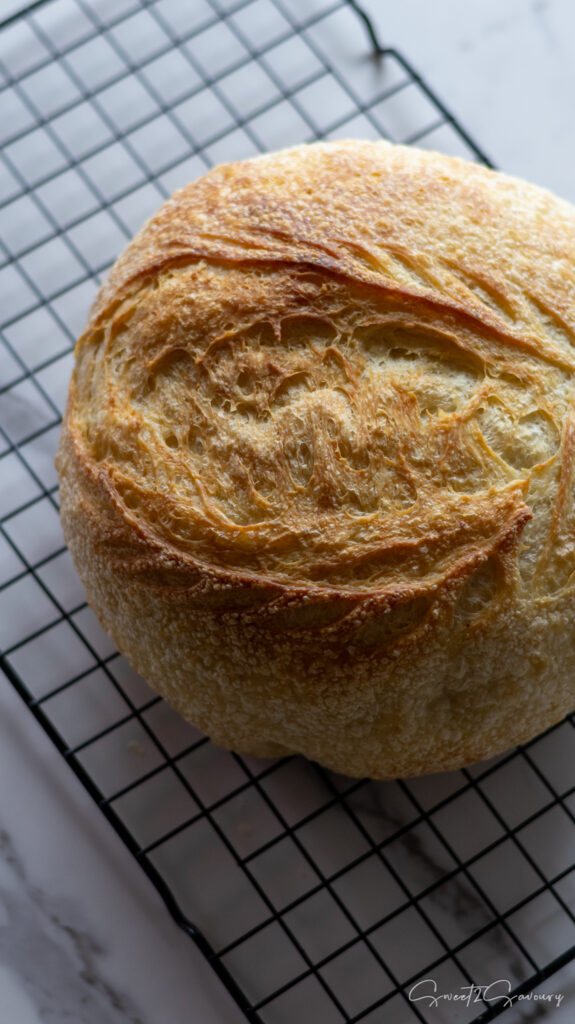
Tips
- Using room temperature ingredients, such as sourdough starter and filtered water, will significantly reduce fermentation time. If you plan on making this recipe, leave your ingredients out the night before to ensure they reach room temperature.
- If your kitchen is cooler (like mine!), to ferment your dough, place the bowl in the oven with the oven light on for gentle warmth. In warmer climates, just leave it on your counter.
- Bread flour is a must, due to its higher protein content, which helps absorb water and develop stronger gluten for a better rise and texture. Unbleached flour is preferred for its denser texture benefits, but bleached bread flour can be used if unbleached is unavailable.
- What is the significance to score bread?
Scoring dough refers to making cuts on the surface of your risen dough with a “lame” (pronounced ‘lahm’). This technique isn’t just for looks; it helps control how the loaf expands while baking. By directing the expansion through the cuts you make, you can achieve a better shape and texture for your bread. - Why does it take 2 days to make this recipe?
The first day is dedicated to preparing the dough and allowing it ample time to ferment while laminating it (stretching and folding). This fermentation period is crucial for developing a stronger gluten structure, which enhances gas retention during baking. The result is a loaf that has a crispy exterior and an airy interior.
The second day results from refrigerating your dough (cold proofing) overnight after fermentation before baking it the next day. Cold proofing enhances gluten structure development and improves bread flavour by slowing down yeast activity, which creates a longer fermentation period and results in a better sour flavor. Additionally, it makes scoring the bread easier. - What is Autolyse (pronounced ‘aw-toe-lease’)?
It is the process of resting the dough after mixing the sourdough starter, flour and water, but before adding other ingredients like salt and sugar. This step is essential for initiating gluten development and ensuring that the flour fully absorbs the water. - Why is it important to use filtered water to make sourdough bread?
Tap water often contains chlorine (and other chemicals), which can slow down or weaken the bacteria in your starter. This can result in poor fermentation and a dough that doesn’t rise properly. To avoid disappointment, use filtered water from the start. Additionally, letting this water reach room temperature before you begin will help the dough rise faster than if you used cold water.

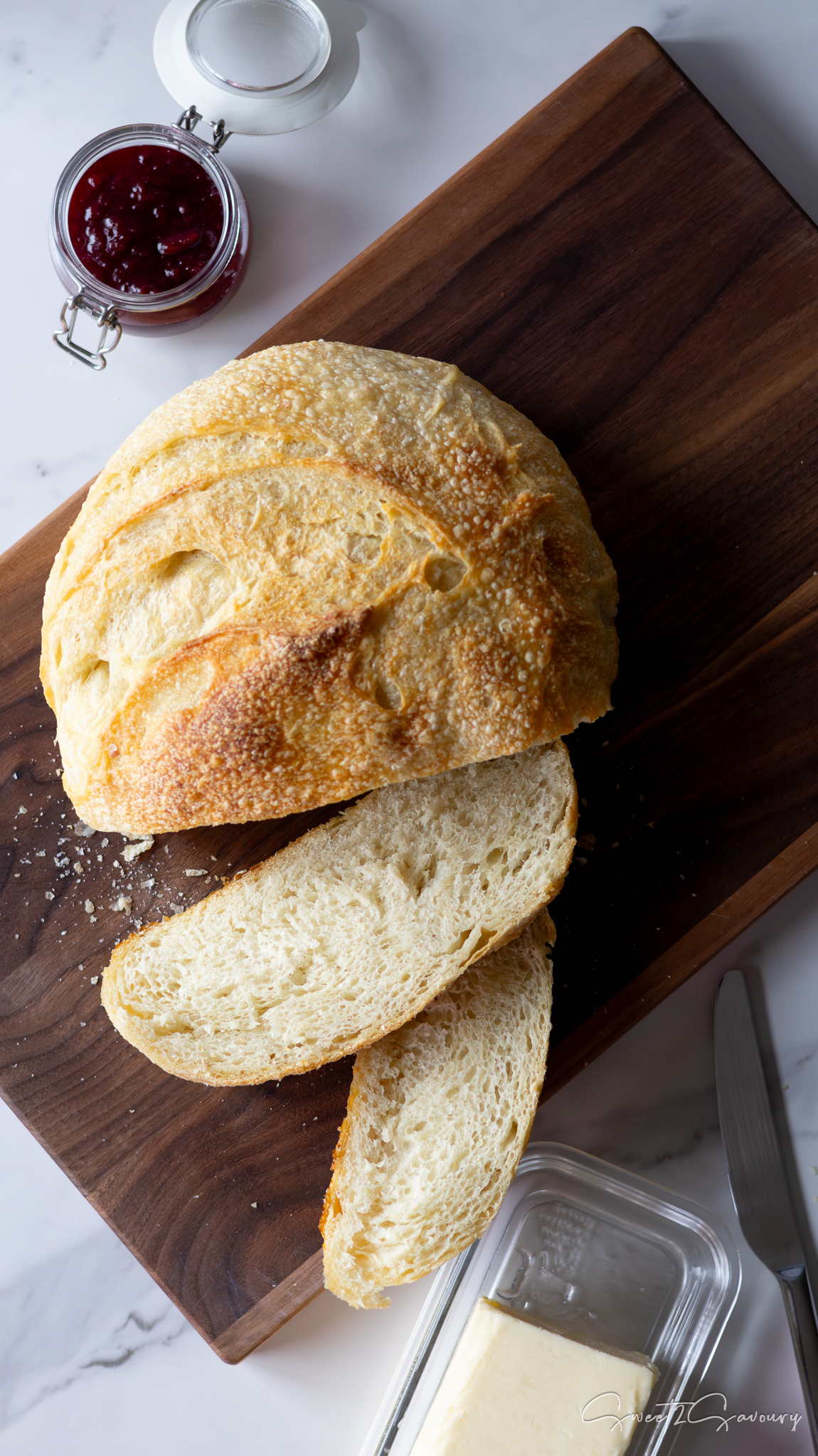
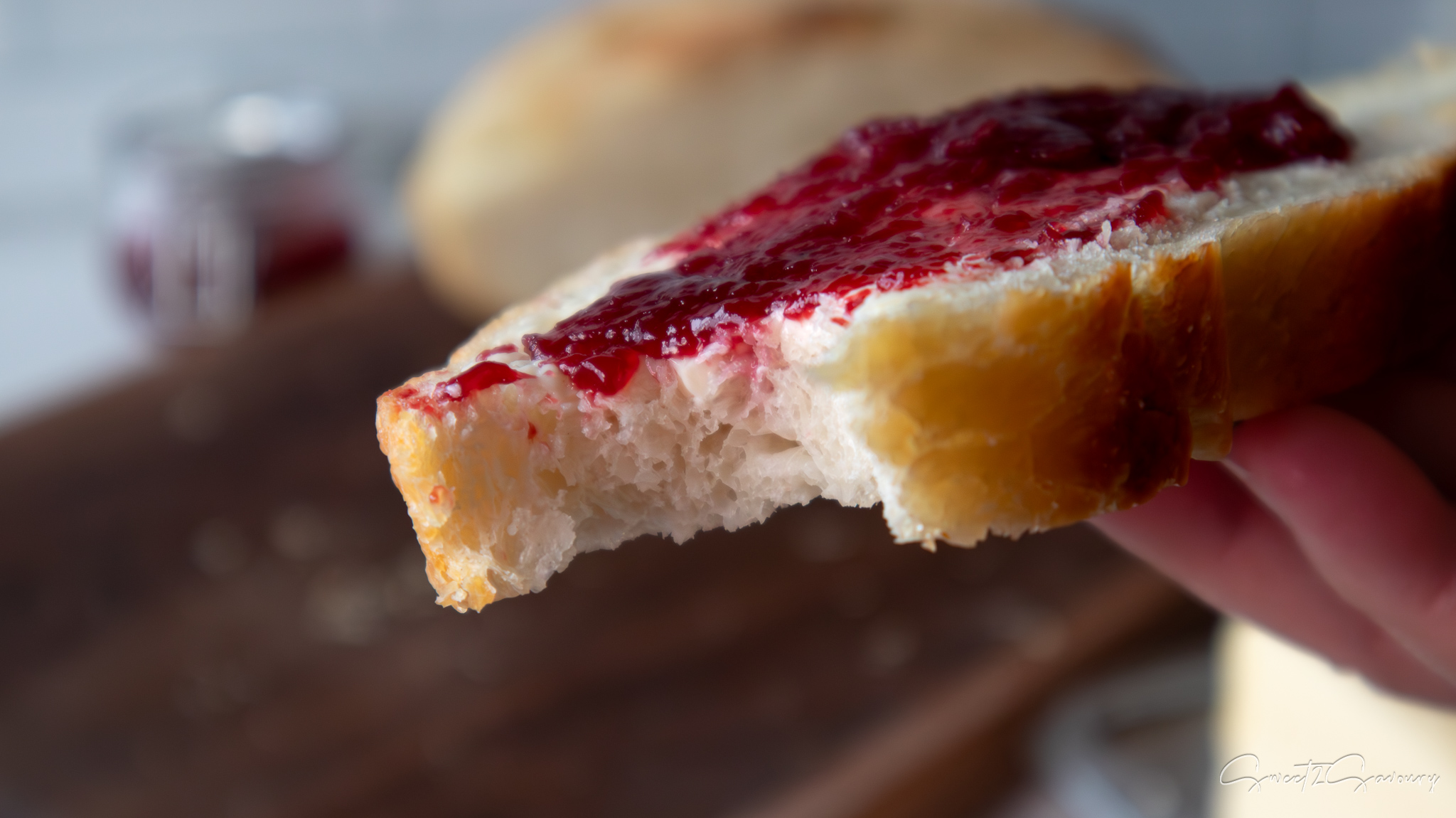
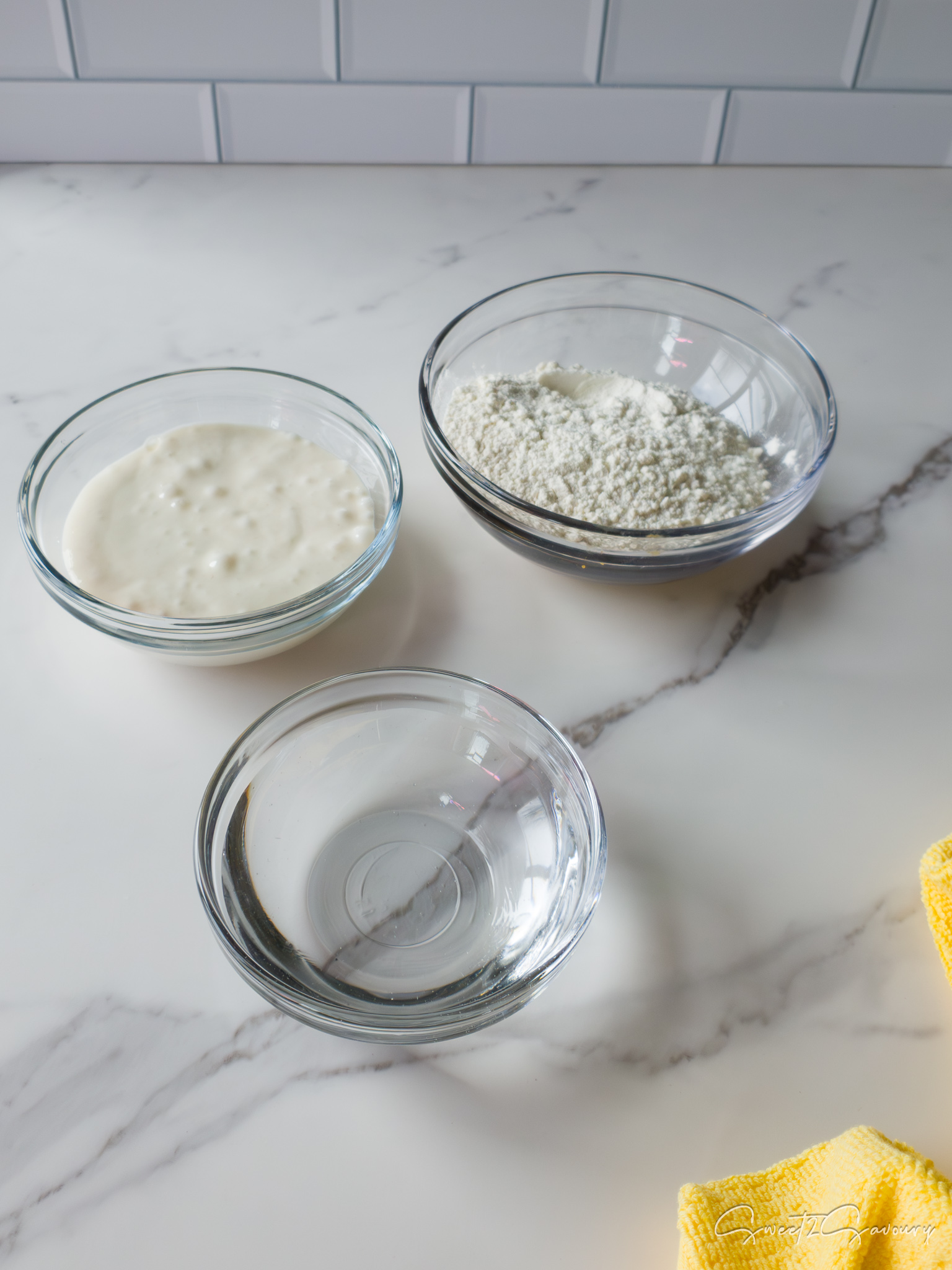
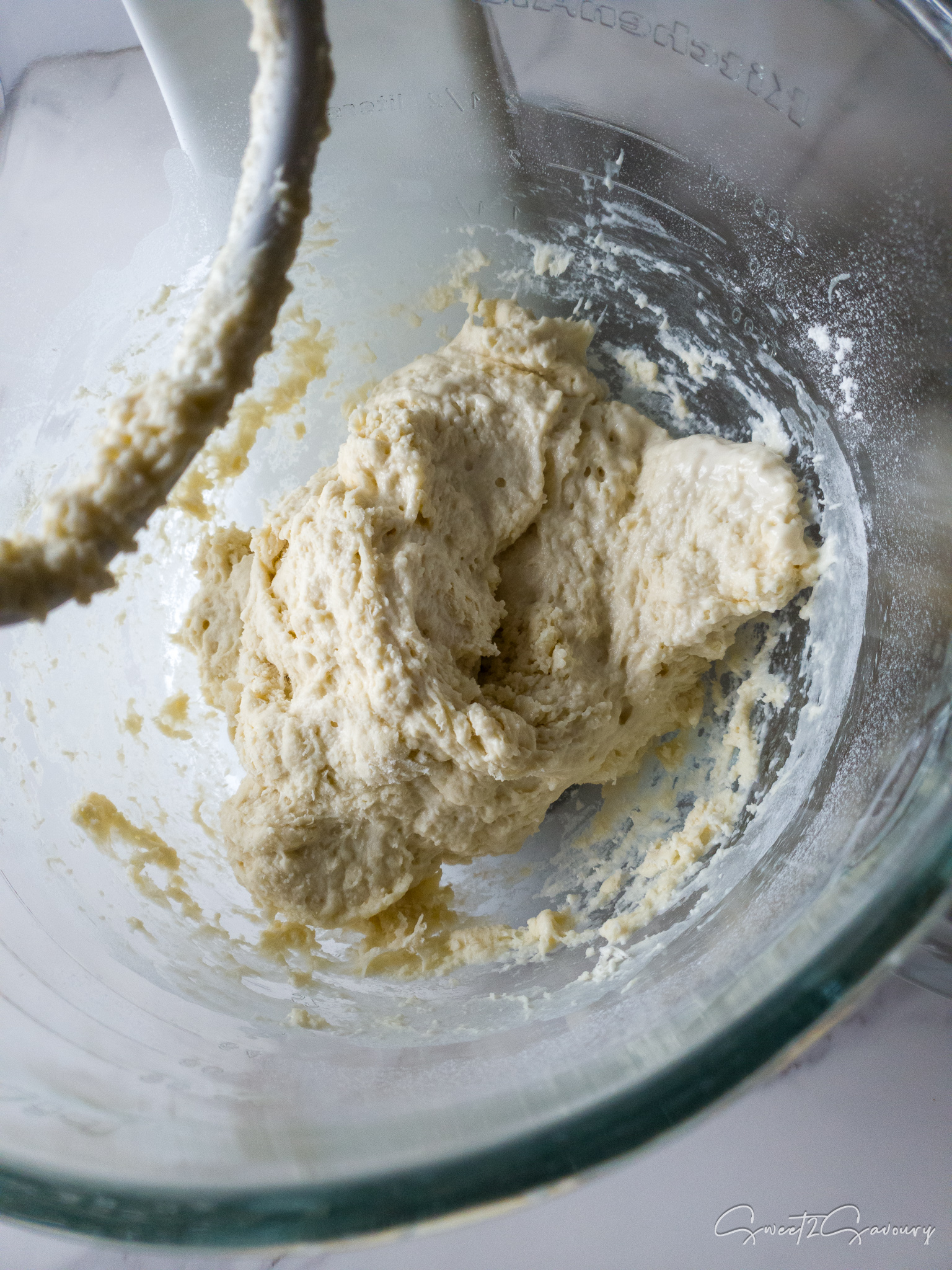
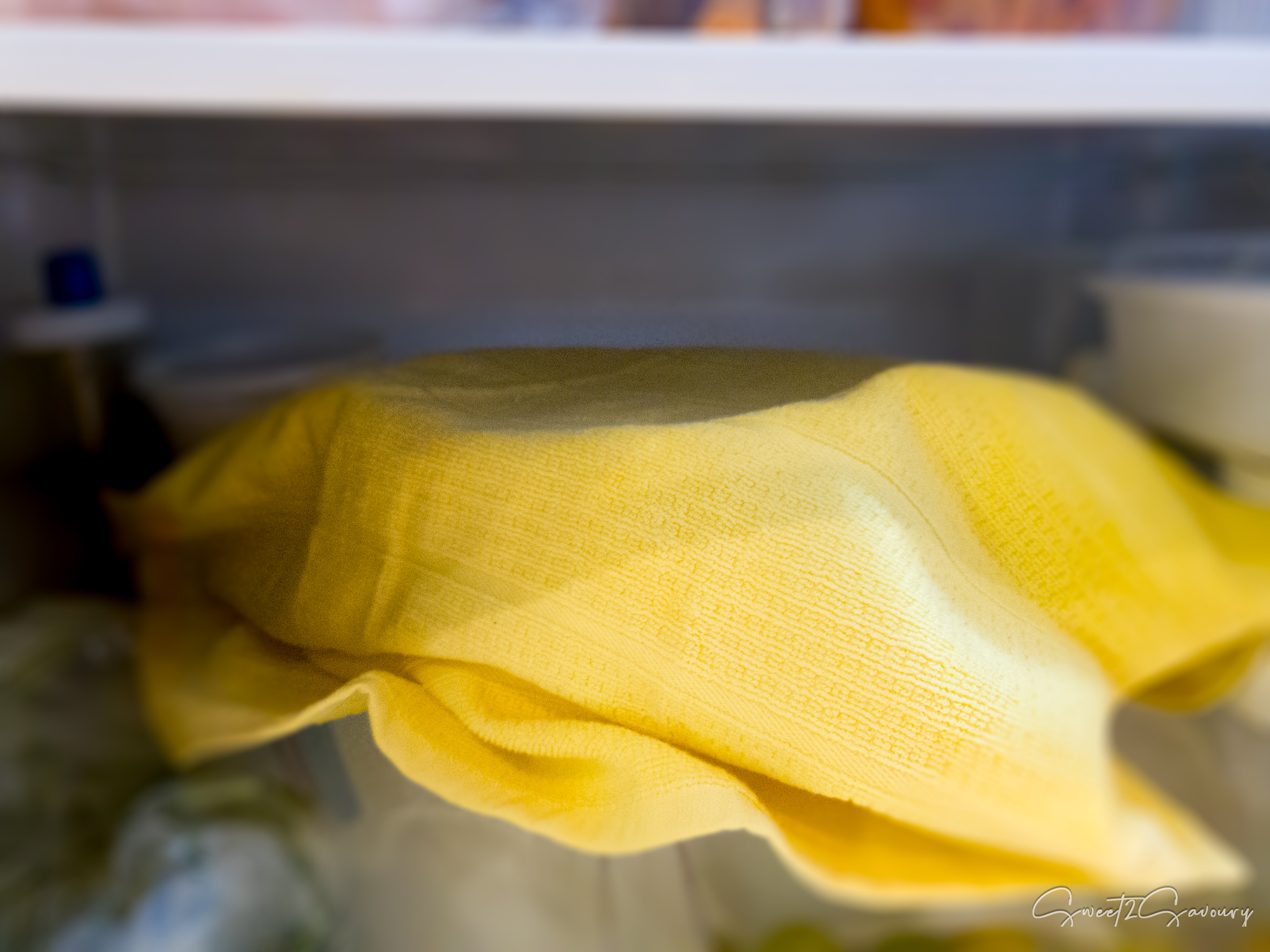
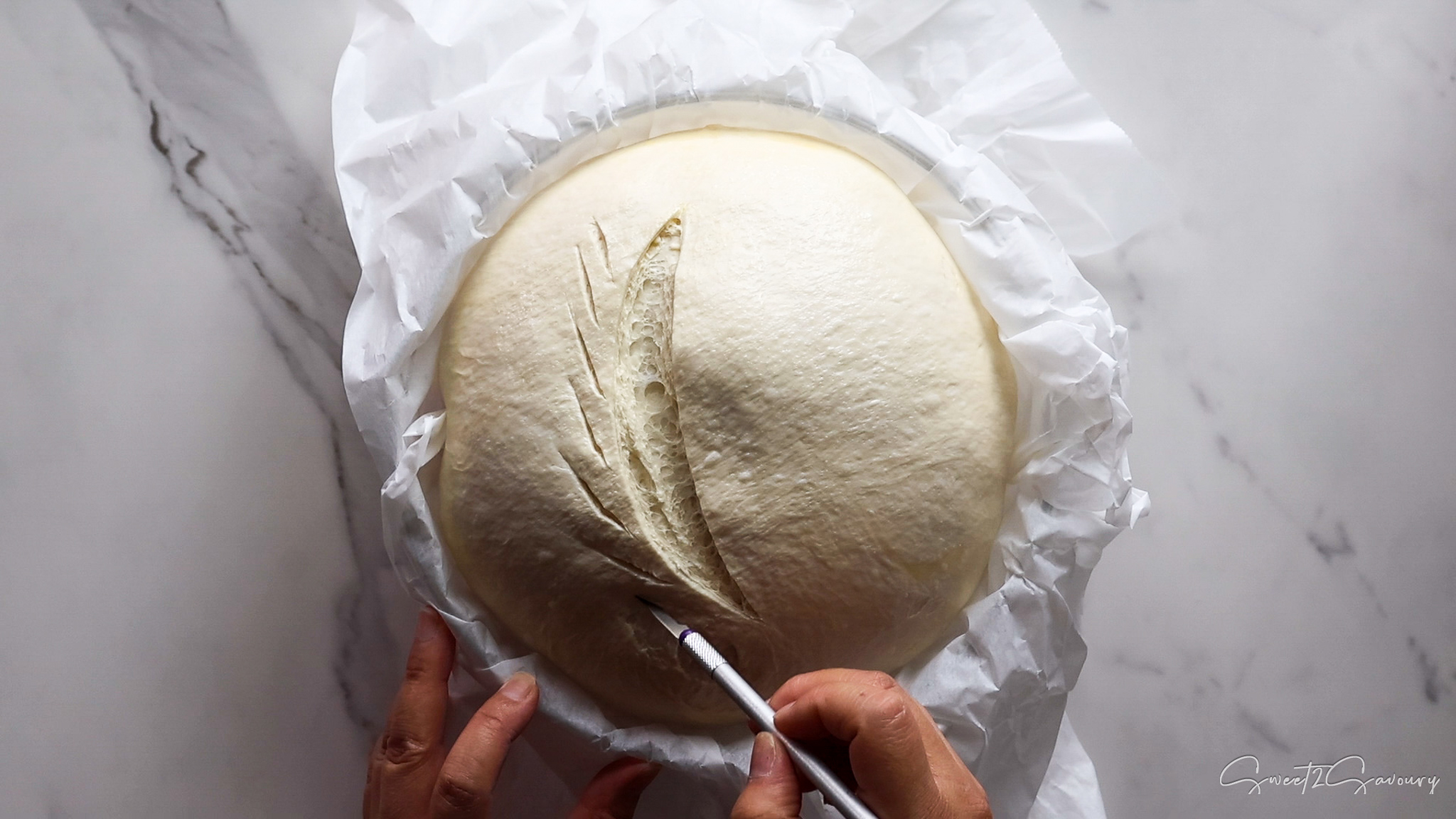
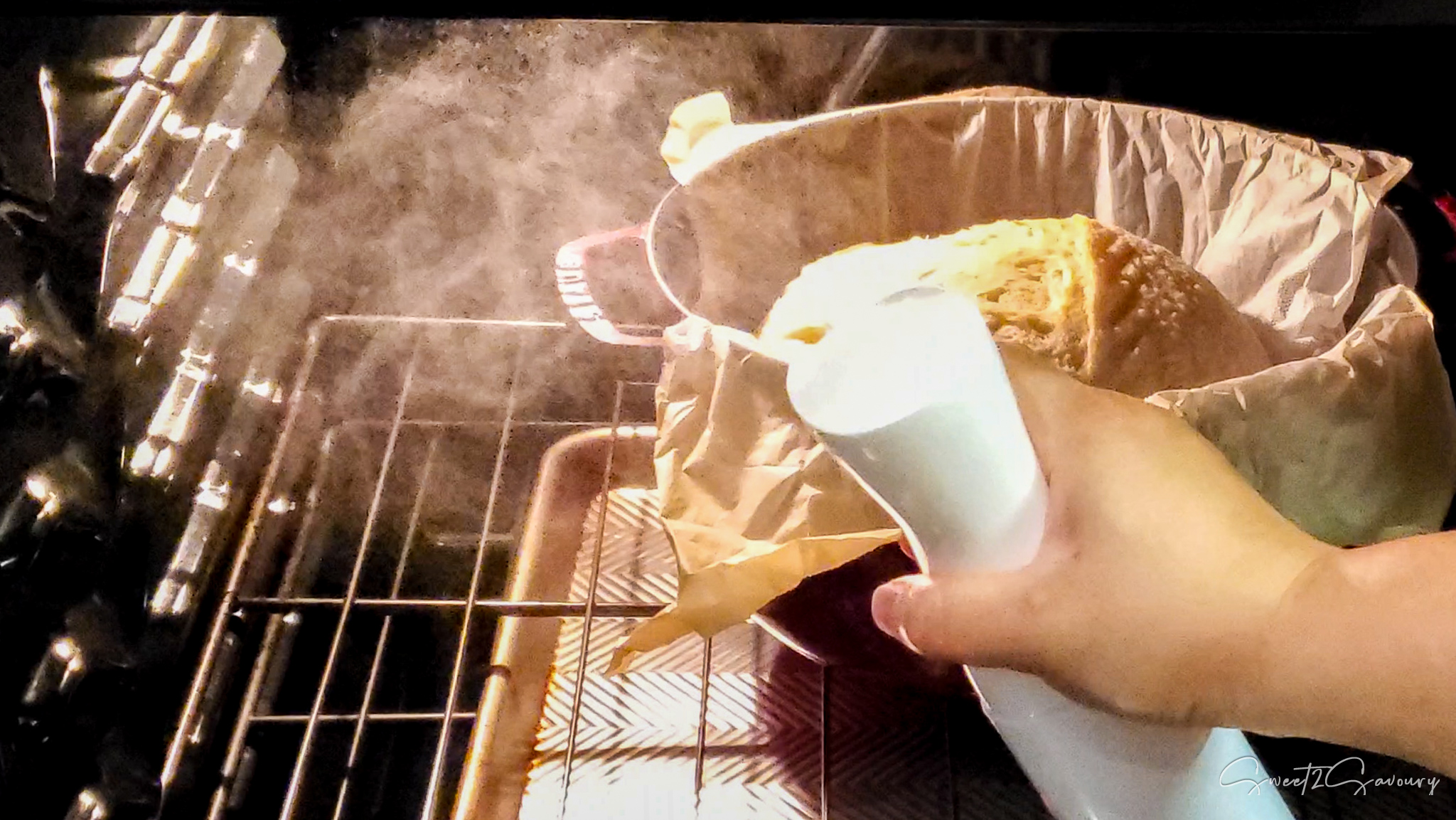
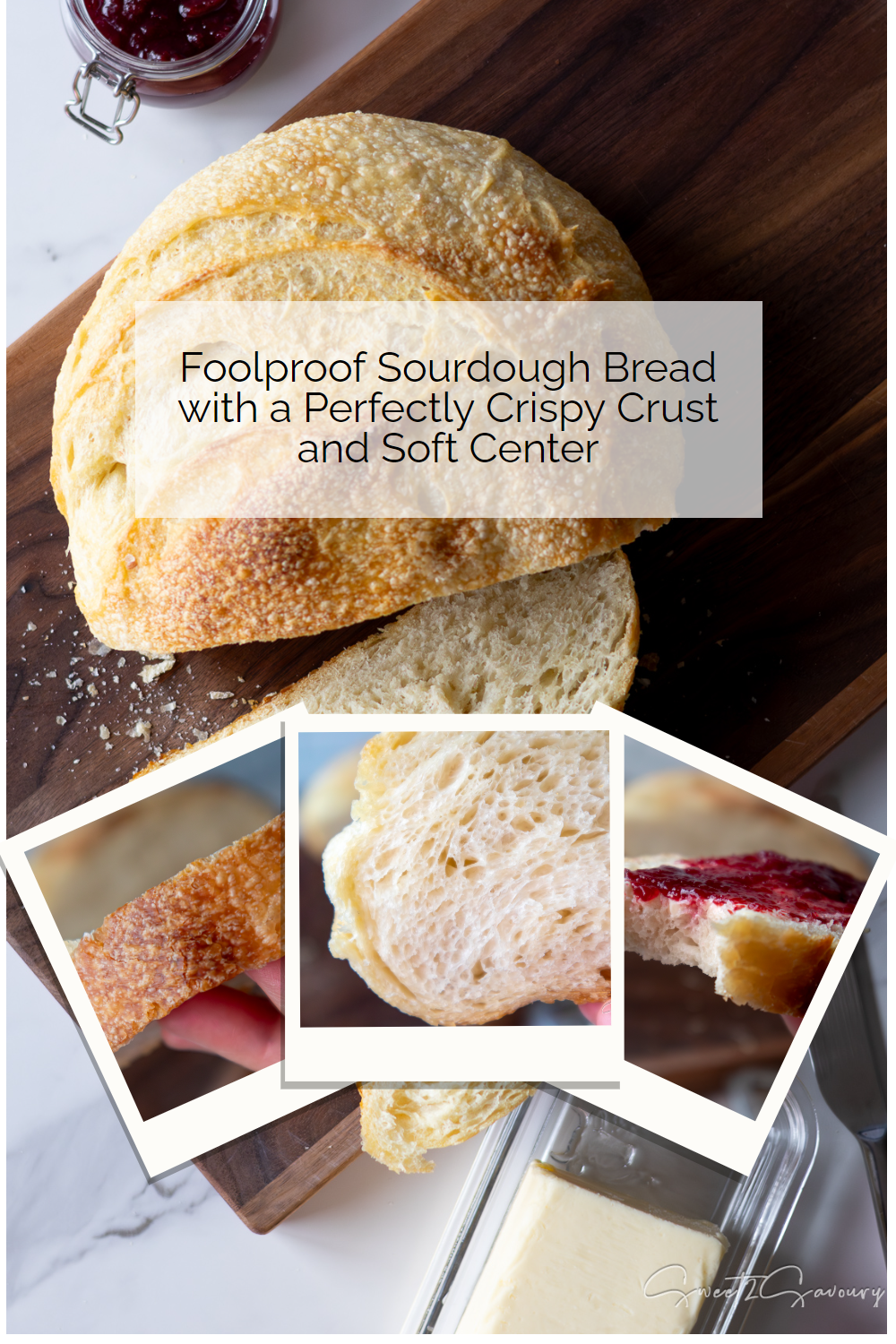
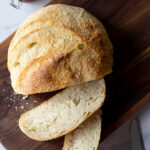

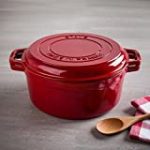



If you enjoyed my recipe, please leave a comment or rate it below. Also don’t forget to follow me on my social media channels (YouTube, Pinterest, Facebook, Instagram, TikTok) to keep up with my latest kitchen shenanigans.